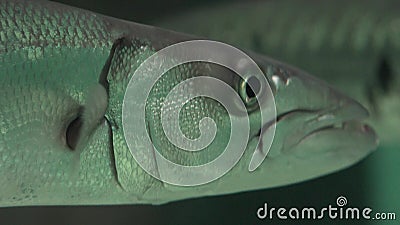

The late Cretaceous Macropoma was technically a coelacanth, and in most respects it was similar to the living representative of the breed, Latimeria. In fact, coelacanths comprise a wide range of fish, some of which are still living and some of which are long gone. Most people use the word " coelacanth" to refer to the presumably extinct fish that, as it turns out, still lurks in the depths of the Indian Ocean. Late Cretaceous (100-65 million years ago) Macropoma (Greek for "big apple") pronounced MACK-roe-POE-ma Still, it's important not to oversell Hypsocormus' credentials compared to, say, a modern bluefin tuna: it was still a relatively primitive "teleost" fish, as evidenced by its armored, and comparatively inflexible, scales. With its forked tail and mackerel-like build, Hypsocormus was one of the speediest of all prehistoric fish, and its powerful bite would have made it unlikely to wriggle off a fishing line considering its overall agility, it may have made its living by pursuing and disrupting schools of smaller fish. If there had been such a thing as sports fishing 200 million years ago, specimens of Hypsocormus would have been mounted in plenty of Mesozoic living rooms.

Middle Triassic-Late Jurassic (230-145 million years ago)Īrmored scales forked tail fin fast pursuit speed Hypsocormus (Greek for "high stem") pronounced HIP-so-CORE-muss Unlike modern lungfish, the gills of which are practically useless, Dipterus seems to have relied on its gills and its lungs in equal measure, which means it probably spent more of its time underwater than any of its modern descendants. (Oddly, the lungfish of the Devonian period weren't directly ancestral to the first tetrapods, which evolved from a related family of lobe-finned fish.)Īs with many other prehistoric fish of the Devonian period (such as the gigantic, heavily armored Dunkleosteus), the head of Dipterus was protected from predators by tough, bony armor, and the "tooth plates" in its upper and lower jaws were adapted to crushing shellfish. In the Paleozoic Era, lungfish were able to survive long periods of desiccation by gulping down air with their lungs, then reverted to an aquatic, gill-powered lifestyle when the freshwater rivers and lakes they lived in filled up again with water. Lungfish-fish equipped with rudimentary lungs in addition to their gills-occupy a side branch of fish evolution, reaching a peak of diversity during the late Devonian period, about 350 million years ago, and then dwindling in importance (today there are only a handful of lungfish species). Middle-Late Devonian (400-360 million years ago) Like many other fossil fish (not to mention aquatic reptiles like plesiosaurs and mosasaurs), Bonnerichthys thrived not in the deep ocean, but the relatively shallow Western Interior Sea that covered much of North America during the Cretaceous period.ĭipterus (Greek for "two wings") pronounced DIP-teh-russ What he found was a large (20 foot long) prehistoric fish that fed not on its fellow fish, but on plankton-the first filter-feeding bony fish to be identified from the Mesozoic Era. Middle Cretaceous (100 million years ago)Īs so often happens in paleontology, the fossil of Bonnerichthys (preserved on a huge, unwieldy slab of rock extracted from a Kansas fossil site) had been stashed unnoticed for years until an enterprising researcher took a closer look at it and made an amazing discovery. Bonnerichthys (Greek for "Bonner's fish") pronounced BONN-er-ICK-thiss


 0 kommentar(er)
0 kommentar(er)
